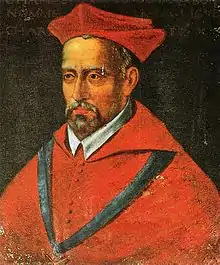Charles de Bourbon (cardinal)
Charles de Bourbon (22 September 1523 – 9 May 1590) was a French cardinal. The Catholic League considered him the rightful King of France after the death of Henry III of France in 1589. His claim was recognized as part of the secret Treaty of Joinville concluded between Philip II of Spain and the League.

Biography
He was born at La Ferté-sous-Jouarre, in what is now the department of Seine-et-Marne, the eighth child of Charles IV de Bourbon, duke of Vendôme.[1] His mother was Françoise d'Alençon.
Charles made a rapid career in the Roman Catholic hierarchy. He was bishop of Nevers (1540–1545), bishop of Saintes (1545–1550, elevated to cardinal in 1548), archbishop of Rouen (1550–1590), bishop of Nantes (1550–1554), Papal legate in Avignon (1565–1590) and bishop of Beauvais (1569–1575). Following the massacre at Wassy and with tensions rising between Guise and Conde forces in Paris, Catherine de' Medici appointed him governor of Paris.[2] Charles attempted to get both to leave Paris to no avail.[2] On 31 December 1578 he was made the first commander in the Order of the Holy Spirit.
When the duke of Alençon and Anjou died childless in 1584 while King Henry III of France was also still childless it was clear that the house of Valois would come to an end with the death of the king and the succession to the French throne would then pass to the house of Bourbon-Vendôme who were descended from Louis IX.[3] However, the senior member of the family, Henry III of Navarre (son of Charles's late elder brother Antoine), was a Protestant.[4] The Catholic League, party to the French Wars of Religion, excluded all Protestants from the succession, which made Charles de Bourbon their champion. In the secret Treaty of Joinville of 31 December 1584 he was recognized by the leaders of the league and a representative of Philip II of Spain as the heir to Henry III of France.[5] Henry III had Charles imprisoned in the castle of Blois on 23 December 1588. He was transferred from one castle to another, presumably to prevent escape. On Henry III's death in 1589, the League proclaimed Charles king, while he was still a prisoner and in the castle of Chinon. He was recognized as Charles X by the parlement of Paris on 21 November 1589. His prison was considered too close to Catholic territory, so he was again transferred, this time to Fontenay-le-Comte. The Catholic League issued coins in his name from 2 August 1589 to his death from 15 Mints, including Paris. Charles, however, renounced the royal title and recognized his nephew Henry IV, whose succession was disputed by the Catholic League. He died in the castle of Fontenay-le-Comte.
When the Comte d'Artois ascended the French throne in 1824, choosing to believe that Charles de Bourbon had never been King, he styled himself Charles X of France.
References
- Andrade & Reger 2016, p. 284.
- Knecht 1989, p. 36.
- Knecht 1989, p. 58-59.
- Knecht 1989, p. 59.
- Martin 1973, p. 131.
Sources
- Andrade, Tonio; Reger, William, eds. (2016). The Limits of Empire: European Imperial Formations in Early Modern World. Routledge.CS1 maint: ref=harv (link)
- Knecht, R.J. (1989). The French Wars of Religion, 1559-1598. Longman.CS1 maint: ref=harv (link)
- Martin, A. Lynn (1973). Henry III and the Jesuit Politicians. Librairie Droz.CS1 maint: ref=harv (link)